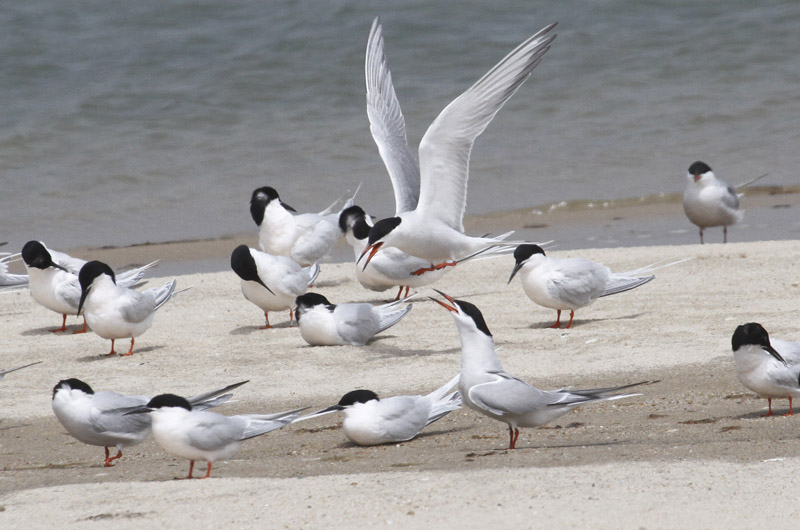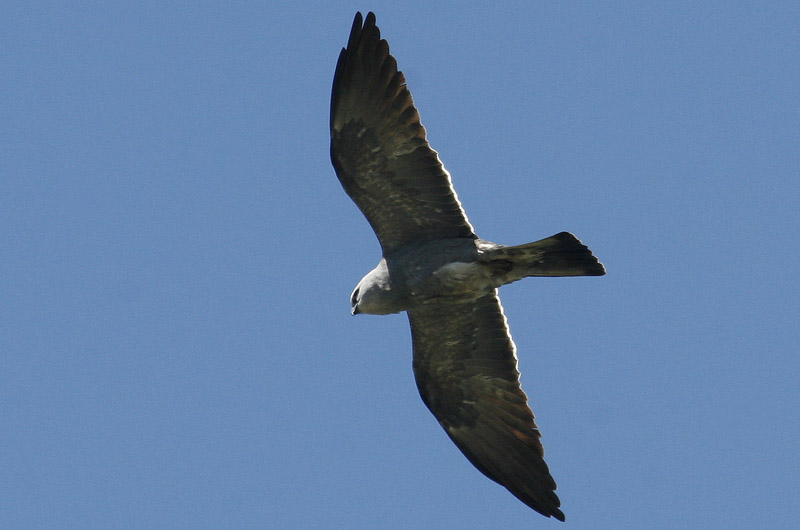Watching the terns that are nesting on Little Beach in Edgartown is spectacular. My Saturday morning guided birding tour observed a lot of terns sitting on their nests as well as other terns arriving and departing from the colony, as we watched from a distance through binoculars and a spotting scope. There are four species of terns nesting there: least, common and roseate terns and the black skimmer.
The best place to watch this colony is from the boat launch ramp located at the end of Pease’s Point Way. From there you will get the best views of the skimmers on their nests and of them skimming low over the water, dragging their lower beak though the water as they feed.
It is critical that you stay away from the colony as you watch. If the terns are dive-bombing at your head, you are too close! Dive-bombing is how the terns warn you that there are nests nearby. The nests are so camouflaged that you will not see them, and it would be easy to inadvertently step on a nest, crushing the eggs. Even if you do not crush the eggs, any disturbance you cause is likely to reduce the nesting success of the colony for any of the following reasons.
We all know how hot the sand gets in the direct sun. Terns lay their eggs in a small scrape on the sand. They do not build a nest the way a robin does. On sunny days the sand can get so hot that the adults stand over the eggs, shading them. If people (or dogs) are too close, the birds fly up, exposing their eggs to the hot sun and sand, and the heat may cook (kill) the eggs. Or, if it is cold (or cold and wet, a double whammy), the eggs may easily become chilled when the adults are disturbed from their incubation.
Increased predation is also a likely result of disturbance. Have you noticed crows and gulls hanging out near nesting colonies? When human disturbance causes the terns to fly and dive-bomb an intruder, the gulls and crows are opportunistic and will take advantage of the unprotected nests to get an easy tern-egg or tern-chick dinner. Skunks and raccoons are also opportunistic predators. When we enter a colony we leave a trail of our scent, which these predators are sure to follow since experience has trained them to associate the human scent with food. And these predators hunt through the night, when they startle adult terns off their nests and then consume their eggs and chicks. They may even kill some of the adults. All of this disturbance-caused predation is mortality that would not happen if there is no disturbance.
So please, by all means watch the spectacle of an active tern colony. But do so from a distance, without disturbing the colony. If the colony flies up into the air, you are too close. Most colonies on the Island are roped off to prevent you from getting too close, but if you are dive-bombed when you are outside the posted area, you still are too close.
If you are dive-bombed in an area that is not posted, or if you see someone else disturbing the colony, please report your discovery to the sheriff’s communications center and to one of the following conservation organizations that post and protect these colonies: BiodiversityWorks, Felix Neck Wildlife Sanctuary, the Martha’s Vineyard Land Bank or The Trustees of Reservations.
Enjoy watching these nesting terns, but do so safely, allowing the terns to nest successfully so that our children and grandchildren will also be able to observe and enjoy the same spectacle.
Bird Sightings
In addition to the spectacle of the nesting terns, there were three highly unusual species found this past week. Each of these species is considered to be a vagrant on the Island because they are not found very often. So it is a three-way tie for bird of the week.
The first unusual species is a black-necked stilt, spotted by Margot Datz as she drove by the marshes along the Edgartown side of State Beach on May 26. She commented “it was so distinctive that I knew I could look it up when I got home.” Indeed, there is little that can be confused with this long-legged, long-necked, slender black and white shorebird. According to Susan Whiting’s Vineyard Birds II, a stilt has not been observed on the Vineyard since 1983.
The second bird of the week is a mourning warbler, photographed by Marsha Eldridge on May 28 as it hopped around on her deck near Iron Hill Farm in Oak Bluffs. That is hardly the typical habitat of this shy and secretive denizen of dense thickets, which, according to Vineyard Birds II, has only been seen twice in the spring, most recently in 1998, though it is found more frequently in the fall. We can only wonder if it had collided with a window, as one eye appears to be closed and both feet are so curled up that it appears to be walking on its knuckles. The good news is the bird recovered and flew away.
The third bird of the week is a Mississippi kite, which was observed on May 31 by Allan Keith, as it flew over his Middle Road Farm, heading west toward Aquinnah. Again from Vineyard Birds II, the only record for this species on the Vineyard is a dead one found by Vern Laux in 1985.
Of the more usual sightings this week, Ken Magnuson reports three blue-winged warblers at Fulling Mill Brook on May 30. And the presence of great crested flycatchers was noted by many observers, including Lanny McDowell, William Waterway, Alison Clark, David and Libby Fielder, Kate Meleney, Sue Shea and Christy Edwards.
Scott Stephens was fishing south of the Vineyard on May 29, and observed a greater shearwater, Wilson’s storm-petrel, and many northern fulmars. These three species are all seen more frequently out on the ocean than they are from the Vineyard.
Hummingbirds appear to be fairly scarce now. Sharon Simonin, Charlie Kernick, Kevin Searle, Lori Robinson Fisher, Catherine Deese, Patricia Rossi, Patricia McNamara, Sue Shea and Katherine Long all report a marked decline in the numbers of hummers coming to their feeders. The most likely explanation for this is that these tiny birds are nesting now, so they tend to be less conspicuous. These observations are only a temporary lull, as there will be more of them visiting feeders in a couple of weeks.
There are lots of birds around, so please get out looking for them, and be sure to report your bird sightings to birds@mvgazette.com.
Robert Culbert leads guided birding tours and is an ecological consultant living in Vineyard Haven.






Comments (1)
Comments
Comment policy »